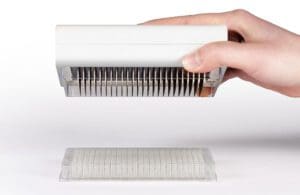
Draper’s PREDICT-96 organ-on-a-chip system
Organ-on-a-chip technology, which simulates the function of an organ or an organ system, has steadily evolved over the past decade.
The promise of the technology has evolved as well, said Timothy Petrie, head of strategy and business development, pharmaceutical R&D technologies at Draper (Cambridge, Mass).
In the beginning, it seemed like the central appeal of organ-on-a-chip technology was to improve the efficiency of drug development. Some 90% of drug candidates fail during clinical development. Organ-on-a-chip technology promises to help drug developers more accurately how a drug will perform in humans.
“With the advent of omics and Big Data applied to secretion and gene expression in proteins at a cellular level, you get a ton more information out of tissue,” Petrie said. That results in new possibilities for organ-on-a-chip research.
The advent of omics has enabled researchers to analyze extracted tissue in minute detail and compare it to in vivo tissue. “You can show that it is indeed the tissue that you want to make and that it should have predictive value,” Petrie explained.
“With an omics analysis, you can get as much data as you possibly can find from every single level of a cell,” Petrie added. “You can map what defines a tissue with these omics modalities and compare it to in vivo tissue.”
In addition, organ-on-a-chip technology can create physiologically relevant complex human tissue on a dish. Given the platform’s modularity, researchers can interrogate and tune them, opening up new research opportunities. “You can get a ton of information that can give you information about new drug targets,” Petrie said.
In addition to predicting what could happen with current drug targets, organ-on-chip technology also can help identify new drug targets and new biomarkers at an early stage.
The evolving capabilities of the platform are fueling a “tsunami of interest,” Petrie said.
Many Big Pharma companies now have a microphysiological system group to validate organ-on-chip models.
It also helps that the EPA is working on phasing out animal testing and the FDA’s validation of organ-on-a-chip data in regulatory approvals. “Once the FDA says, ‘Hey, this is useful data for your approval,’ pharma will follow,” Petrie said.
The pandemic has helped ramp up interest in the technology, but the industry’s appetite for organ-on-a-chip technology was already on the upswing beforehand, Petrie said.
There are a variety of reasons why. Such systems can help researchers investigate why individuals may have a unique response to the same drug.
Organ-on-a-chip technology can also help drug companies understand the toxicity of a drug candidate. “About 60% of drug candidates fail because of efficacy issues, and about 30% fail as a result of toxicity,” Petrie said. “It is a huge problem.”
Organ-on-a-chip technology could potentially help study off-target effects, where a drug that is supposed to have a certain mechanism of action can have off-target deleterious actions on other tissues. Such off-target effects can cause drugs to fail human trials.
Draper’s Human Organ Systems (HOS) can array 96 independent single organ models.
Drug developers could use organ-on-a-chip technology to study, say, 10 different tissues. “You put your drug in those tissues, and you can quickly and rapidly understand the toxicity within those tissues and predict if it will have those off-target effects,” Petrie said. “That’s a next-generation thing that we’re working on.”
Filed Under: clinical trials, Drug Discovery, Drug Discovery and Development





Tell Us What You Think!
You must be logged in to post a comment.